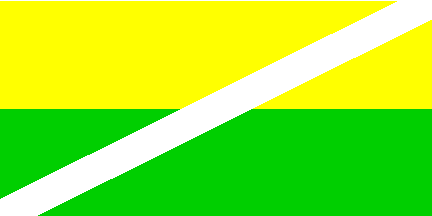 image by Ivan Sache, 11 March 2017
image by Ivan Sache, 11 March 2017
Last modified: 2024-03-02 by rob raeside
Keywords: education |
Links: FOTW homepage |
search |
disclaimer and copyright |
write us |
mirrors
See also:
Other Institutions:
 image by Ivan Sache, 13 May 2021
image by Ivan Sache, 13 May 2021
Escuela Agropecuaria de Paratebueno (Cundinamarca) was established by
Resolution No. 1,320 issued on 7 May 1965. The school acquired on 1978 a farm of 21.7 ha for practical training.
Institución Educativa Departamental Agrícola Paratebueno was established by Resolution No. 3,391 issued on 30 September 2002.
The flag of IEDA Paratebueno is diagonally divided, from lower hoist to upper fly, white-green-red.
Sources: school website and school symbols page
Ivan Sache, 13 May 2021
 image by Ivan Sache, 11 March 2017
image by Ivan Sache, 11 March 2017
Instituto Cooperativo Agroindustrial (ICTA) originates in Colegio
Departamental Helena Olózaga de Echavarría, established in 1985 in the Paulo VI
borough, Puente de Piedra, Madrid, Cundinamarca Department. Its branch dedicated
to agriculture and cattle-breeding, Instituto Cooperativo Técnico Agropecuario
Helena Olózaga de Echavarría, was transferred in 2004 to Corporación Educativa
Minuto de Dios, a corporation founded in 1958 by Father Rafael García Herreros
Unda (1909-1992) , which manages 24 educational institutes all over Colombia,
and renamed to its current name.
http://www.colegiosminutodedios.edu.co/icta - Institute's website
The
flag of ICTA is horizontally divided yellow-green with a white ascending
diagonal stripe all over.
http://www.colegiosminutodedios.edu.co/icta/index.php/quienes-somos/nosotros/simbolos
- Institute's website
Ivan Sache, 11 March 2017
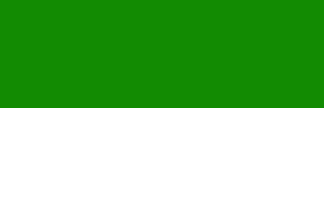 image by Ivan Sache, 16 June 2018
image by Ivan Sache, 16 June 2018
Colegio Nacional Agustín Codazzi was established in April 1968.
The flag of Colegio Nacional Agustín Codazzi is horizontally divided
green-white.
Green is a symbol of faith and stoic and incommensurate work.
White is a symbol of purity and peace.
Source:
Manual de Convivencia
Ivan Sache, 16 June 2018
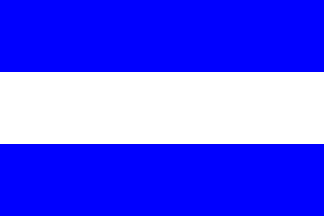 image by Ivan Sache, 15 January 2004
image by Ivan Sache, 15 January 2004
"Colegio Distrital 'Agustín Fernández'", located
in Bogotá, is named after Agustín Fernández (1879-1908), a
pioneer of telegraph in Colombia, murdered in Bogotá. In 1929,
his father, Francisco Javier Fernández Bello, offered a plot of
land for the building of a rural school to be named after his
defunct son.
The flag of the institute, as shown graphically and described on
the website
of the institute, is horizontally divided blue-white-blue.
Blue, on the first stripe, represents the light enlightening the
way to knowledge, triggering creativity and facilitating
communication. White represents peace, respect and tolerance.
Blue, on the second stripe, represents love and knowledge
transmitting energy and tranquility.
Ivan Sache, 15 January 2004
 image by Ivan Sache, 3 January 2021
image by Ivan Sache, 3 January 2021
Institución Educativa Agustín Nieto Caballero is located in Betoyes, Tame
(Arauca).
The school is named for the writer, lawyer and educationalist
Agustín Nieto Caballero (1889-1975), founder of Gimnasio Moderno (1914) and
Gimnasio Femenino (1927) in Bogotá, also Minister of Education and Rector of the
National University of Colombia.
www.banrepcultural.org/blaavirtual/biografias/nietagus.htm
Complete
biography
The flag of IE Institución Educativa Agustín Nieto Caballero is
diagonally divided white-green from the lower hoist to the upper fly, with three
red stars placed on the diagonal.
school blog, 30 July 2016
Ivan Sache, 3 January 2021
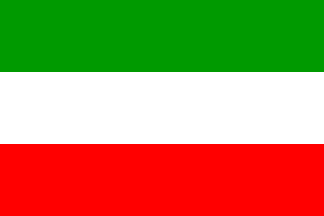 image by Ivan Sache, 18 March 2017
image by Ivan Sache, 18 March 2017
Source: Institute Constitution
Ivan Sache, 18 March 2017
Institución Educativa Agustín Nieto Caballero is located in Commune 11, Cali,
Valle del Cauca Department. The institute is named for the writer, lawyer and
educationalist Agustín Nieto Caballero (1889-1975), founder of Gimnasio Moderno
(1914) and Gimnasio Femenino (1927) in Bogotá, also Minister of Education and
Rector of the National University of Colombia..
Complete biography
The symbols of the institute are prescribed in the institute's
Constitution, adopted on 18 January 2017.
The flag is horizontally divided
green-white-red.
Green, as a symbol of knowledge, represents the
natural environment as God's wisdom.
White, as a symbol of being, represents
the man as an integer, pure, honest and genuine human being.
Red, as a symbol
of social skills, represents vigour, energy, enthusiasm and commitment to be
competent.
Institute Constitution -
Ivan Sache, 18 March 2017
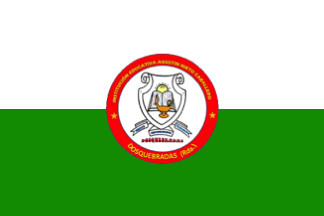 image by Ivan Sache, 3 January 2021
image by Ivan Sache, 3 January 2021
Institución Educativa Agustín Nieto Caballero (IEANC) was established in
Frailes, Dosquebrada (Risaralda) by Decree No. 103 issued on 28 February 1977.
Classes started on 23 March 1977.
The school is named for the writer, lawyer
and educationalist Agustín Nieto Caballero (1889-1975), founder of Gimnasio
Moderno (1914) and Gimnasio Femenino (1927) in Bogotá, also Minister of
Education and Rector of the National University of Colombia.
Complete biography
The flag of IEANC is horizontally divided white-green with the
school's coat of arms in the center.
Green is the region's dominant color,
reflecting the soil's fertility, and symbolizes aspiration to a better future.
White is a symbol of purity and perfection obtained by cultivating our most
positive values and feelings.
The shield is heart-shaped, with the edges rolled like a parchment. Beneath the shield, a scroll is inscribed with the school's basic values, "RESPETO RESPONSABILIDAD TOLERANCIA" (Respect Responsibility Tolerance). In the center, the sun, as the source of all energy and the symbol of life, jointly with the burning lamp, enlightens the road towards an open concern for knowledge and human coexistence. The open book means the infinite possibilities offered by knowledge that unite men and recall their common origin.
Sources: IEANC website and symbols
Ivan Sache, 3 January 2021
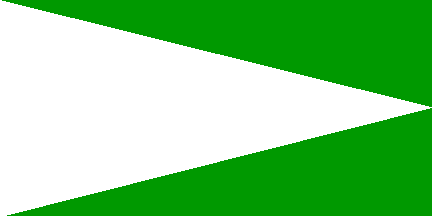 image by Ivan Sache, 27 September 2014
image by Ivan Sache, 27 September 2014
Colegio San Agustín was established in 1937 in Simijaca (Cundinamarca
Department), on a plot bequeathed to the municipality by Agustín Parra "to
provide education and Christian instruction to the children of my family and to
other young people, children of poor parents with recognized worthiness". In
1940, the school was reorganized and renamed Colegio María Auxiliadora, and, in
1953, Colegio Agustín Parra. Institución Educativa Agustín Parra was established
by Resolution 3,770 of 6 November 2004, as the merger of Institución Educativa
Integrada Agustín Parra, Concentración Urbana La Estación, Concentración Urbana
Manuel Briseño, Concentración Urbana Antonio Nariño, Concentración Urbana
Policarpa Salavarrieta, Escuela Rural Aposentos Cristales, Escuela Rural Don
Lope No. 2, Escuela Rural Don Lope No. 1, Escuela Rural El Fical, Escuela Rural
El Juncal, Escuela Rural El Ruchical, Escuela Rural El Santuario, Escuela Rural
Peña Blanca, Escuela Rural San Francisco, Escuela Rural San José, Escuela Rural
San Rafael, and Escuela Rural Aposentos Taquira.
The flag of the institute, designed in 1983 by Juan Murcia Varela, is green with
a white triangle placed along the hoist and reaching the fly. Green represents
the pastures and the fields, and is a symbol of hope. White is a symbol of
honesty, frankness, and enthusiasm.
Source:
http://ieagustinparrasimijaca.blogspot.fr/ - Institute's blog
Ivan Sache, 27 September 2014
 image by Ivan Sache, 29 June 2014
image by Ivan Sache, 29 June 2014
Colegio Agustina Ferro was established in Ocaña (Norte del Santander
Department) by Departmental Ordinance No. 46 of 30 November 1961. Decree No.
855, adopted in 2002, merged Colegio Agustina Ferro, Colegio de Educación media
Fatima, Escuela Simón Bolivar and Escuela el Carmen to form Institución
Educativa Agustina Ferro. The institute is named for Agustina Ferro, a heroin of
the Colombian independence shot on 20 January 1820 in Ocaña by the Colorado
royalist guerilla.
The flag of the institute is white with the institute's emblem in the middle.
The emblem of the institute features a book an a lamp always enlightening
knowledge and science, a scroll inscribed with the words "CONOCIMIENTO
INTEGRIDAD VALORES" [Knowledge Integrity Values]. Accordingly, the emblem means
"an integrated education based on the light of knowledge and on values".
Source:
http://www.colagustina.edu.co/index.php/institucional/2013-09-30-02-41-36/himno-y-simbolos/escudo
- Institute's website
Ivan Sache, 29 June 2014
 image by Ivan Sache, 28 July 2011
image by Ivan Sache, 28 July 2011
The Order of Augustinian Recollects manages in Colombia one university (Uniagustiniana)
and eight schools (Colegio Agustiniano Norte, Colegio Agustiniano Suba, Colegio
Agustiniano Salitre, Colegio Agustiniano Floridablanca, Colegio Agustiniano
Medellin, Colegio Agustiniano Palmira, Colegio Agustiniano Tagaste).
The
schools all use the same generic flag, horizontally divided red-blue.
Red is
the symbol of a youth that is proud, chaste, valiant, eager of science and
virtue, unquiet, in permanent quest.
Blue is the symbol of the Augustinian
spirit, guided by infinite horizons that will always be there in life's
difficult episodes.
https://agustinianonorte.edu.co/simbolos/ Colegio Agustiniano Norte website
https://agustinianosuba.edu.co/wp-content/uploads/2020/06/MANUAL-DE-CONVIVENCIA-2020.pdf
Colegio Agustiniano Suba, Manual de Convivencia
http://www.agustinianosalitre.edu.co/Home/Institucion/0 Colegio Agustiniano
Salitre website
https://aguscampestre.edu.co/?page_id=44 Colegio Agustiniano Palmira website
https://www.agustinianotagaste.edu.co/pei/#1583247062080-29a306cd-5b07
Colegio Agustiniano Tagaste, Manual de Convivencia
Ivan Sache, 15 December 2020
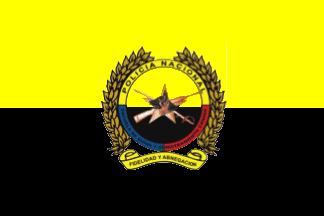 image by Ivan Sache, 22 March 2019
image by Ivan Sache, 22 March 2019
Agente Álvaro Rojas Ahumada School of Canine Guides and Training (Escuela de
Guías y Adiestramiento Canino "Agente Álvaro Rojas Ahumada" - ESGAC) is located
in Facatativá (Cundinamarca Department).
The first section of police dogs
was established in Colombia in 1913, on the model of similar sections operated
in France, Germany and England. The Center of Dog Training (Centro de
Adiestramiento de Perros - CAP)
was established in 1963, to be renamed in
1993 to Dog Training School (Escuela de Adiestramiento de Perros - ESAP), and to
ESGAC in 2003.
http://guiascaninospolicianacionalcolombia.blogspot.com, ESGAC blog
The school was named in 2010 for Agente Álvaro Rojas Ahumada. "the first canine
guide heroically fallen during the operation that led to the death of rascal
Sangre Negra". The policeman was killed on 26 May 1963
in Yopó, borough
Platanillo, El Líbano (Tolima Department) in a fighting against a band of
rascals.
https://historiapolicianacionaldecolombia.blogspot.com/2016/03/tras-las-huellas-de-los-guias-caninos.html,
Fernando García Fernandéz' blog, 29 March 2016
The flag of ESGAC is
horizontally divided yellow-black with the school's coat of arms in the center.
The yellow stripe represents the member's spirit and firmness. The black stripe
represents the impartial authority of the guides in the service of the
community.
The shield of ESGAC is surrounded by a circular stripe divided
into three sectors with the national colors. The upper half is yellow, inscribed
with "POLICIA NACIONAL" in black bold letters, the lower part is blue on the
left and red on the right, inscribed with "ESCUELA DE GUÍAS Y ADIESTRAMIENTO
CANINO" in black bold letters. The center of the shield, on a yellow background,
features the National Police's star, superimposed with a saber and a rifle
crossed in saltire, and, all over, the head of a German Shepherd dog, looking at
the
shield's dexter. The whole is surrounded by laurel wreaths and, in the
lower part, a scroll inscribed with "FIDELIDAD Y ABNEGACIÓN" [Loyalty and
Abnegation] in red letters on a yellow field. The motto recalls the loyalty of
the dog to the guide and the abnegation of the guide to the dog.
The
circular shape of the shield is considered as the most perfect figure and the
most appropriate representation of the deity, invoking the Lord of truth and
justice. The yellow, blue and red colors represent the national tricolor flag,
symbolizing loyalty to the homeland and love to the institution. The
five-pointed star is the universal Police's emblem, representing adoration to
the world's supreme governor. The five points represent the divine attributes:
Greatness, Virtue, Light, Majesty and Peace. The saber and the rifle are the
carabineers' specific weapons, symbolizing the union of all specificities of the
service. The dog is the symbol of the element required to the guide's protection
and operationality.
https://www.policia.gov.co/escuelas/guias-caninos/simbolos National Police
website
Ivan Sache, 22 March 2019
 image by Ivan Sache and Peter Hans van den Muijzenberg, 13 September 2014
image by Ivan Sache and Peter Hans van den Muijzenberg, 13 September 2014
IDEM Niquia was established in Bello (Antioquia Department) by Decree No. 289
of 1 March 1983 and renamed IDEM Fé y Alegría Alberto Lebrun Muñera by Decree
No. 16 of 17 June 1986.
Source:
http://iealbertolebrun.wordpress.com/ - Institute's website
The flag of the institute is diagonally divided, per bend sinister, green-red,
with a golden staff. The diagonal is made of two thin white-red stripes. The
flag can be used either without or with the institute's emblem, then placed in
the flag's "upper part".
Green is a symbol of hope. Red is a symbol of tenacity, struggle, and liberty.
The diagonal stripes are a symbol of belonging and commitment to give and
love. The golden staff is a symbol of the potential resources hold by everyone,
especially students.
Source:
http://iealbertolebrun.wordpress.com/nuestra-bandera/ - Institute's website
The emblem of the institute is inscribed with the motto "EDUCACION, LIBERTAD,
CULTURE" (Education, Liberty, Culture). The book and the mountain placed in the
upper part represent education and the way to it, respectively. The handshake
represents the union of all people involved in the good management of the
institute. Green is a symbol of aspiration to a better future. Grey is a symbol
of working spirit. Yellow is a symbol of knowledge. Red is a symbol of life.
Coffee brown is a symbol of dexterity and skill. White is a symbol of purity.
Source:
http://iealbertolebrun.wordpress.com/nuestro-escudo/ - Institute's website
Ivan Sache, 13 September 2014
Is this "bearing a golden staff", or "its flagstaff being gold-coloured"?
By accident we had two such stripes, but they were to far apart to form a single
diagonal. As a stop-gap measure I filled in the gaps with red and white.
But I wonder whether we need some sort of shading to indicate the red diagonal
on the red stripe. I now that part of the design will not be very strong,
regardless, but if one could see the red diagonal continuing, then at least the
design would make sense.
Hm, interesting, those colours. Hope apparently is an aspiration to a better
future, while life is filled with tenacity, struggle, and liberty.
Peter Hans van den Muijzenberg, 13 September 2014
They do draw
it that way. But in the
photograph, it doesn't look like that.
Source:
https://iealbertolebrun.wordpress.com/eventos/
But do you guys otherwise think of the flag in the photograph, BTW?
Peter Hans van den Muijzenberg, 11 April 2015
Variants:
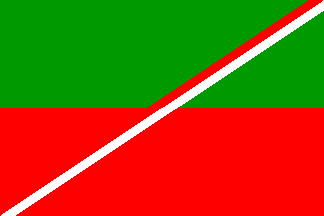 image by Peter Hans van den Muijzenberg, 14 May 2015
image by Peter Hans van den Muijzenberg, 14 May 2015
Redrawn to improve the diagonal
 image by Peter Hans van den Muijzenberg, 14 May 2015
image by Peter Hans van den Muijzenberg, 14 May 2015
A different direction
I myself think it doesn't look so much like a bi-colour green over red, over
all a bi-colour narrow rising diagonal, red over white - as like a bi-colour
narrow rising diagonal, white over red.
Peter Hans van den Muijzenberg, 14 May 2015
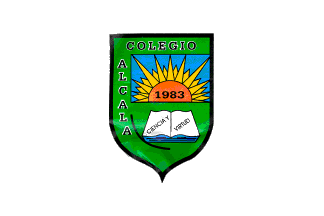 image by Ivan Sache, 9 January 2004
image by Ivan Sache, 9 January 2004
The College was founded in 1983. Its flag is white with the
shield of the College in the middle.
Source:
www.voluntad.com.co,
located by Dov Gutterman.
Ivan Sache, 9 January 2004